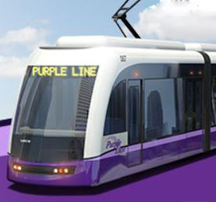Do Not Delay the Bethesda South Metro Entrance
Testimony to the Montgomery County Council CIP Hearing
Presented by ACT Vice President Cavan Wilk, February 7, 2012
The busy Bethesda Metro station desperately needs more rider capacity. Now is not the time to delete funding from the CIP budget to build a southern entrance to the station. Plans have long called for a second entrance toward the southern end of the platform. It was assumed that a southern entrance would be built at some point in the future when the station began service in 1984.
However, the MTA has clearly stated that construction on the entrance would have to begin by 2016 in order to meet the 2020 start of operations for the Purple Line. Under the County Executive’s proposed CIP for the Bethesda South Metro Entrance, construction wouldn’t begin until after FY18, which would be too late for the station to be operational when the Purple Line begins service.
In addition to all its other benefits, building the new entrance reaffirms shows the strength of our county’s support for the Purple Line.
While the new southern entrance was conceived as a bank of elevators that would connect the Red Line and future Purple Line, it would also serve as a second entrance to the Red Line, regardless of whether or not a transit rider is transferring. Therefore, its construction is not dependent on Purple Line groundbreaking.
A new entrance would immediately benefit Red Line riders the day it opens. Because escalators need to be periodically rebuilt, single-escalator bottleneck situations in the Bethesda Metro station are largely unavoidable under the status quo. Metro riders also deal with the frustrating situation when the long escalators (the second longest in the system after Wheaton) between the street and mezzanine break down. While able-bodied transit riders are able to make the long climb, injured, disabled, or elderly people could have trouble making it to the surface.
Because of the ongoing global credit crunch, interest rates remain historically low. Part of the cost of any project is the cost of obtaining financing. As anyone with a mortgage knows, a lower interest rate lowers the monthly payments to service the construction bond.
In summary:
-
Building the new entrance to the Bethesda Metro reaffirms the strength of our county’s support for the Purple Line.
-
The escalators that go between the mezzanine and the platform will need to be rebuilt again. The Bethesda Metro will again be cramped and frustrating, discouraging county residents from taking transit.
-
Current escalator capacity is inadequate in an emergency situation.

